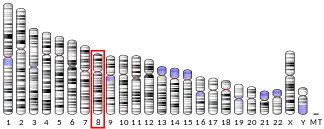RNF139
RING finger protein 139, also known as TRC8, is a protein that in humans is encoded by the RNF139 gene.[5][6]
The protein encoded by this gene is a multi-membrane spanning protein containing a RING-H2 finger. This protein is located in the endoplasmic reticulum, and has been shown to possess ubiquitin ligase activity. This gene was found to be interrupted by a t(3:8) translocation in a family with hereditary renal and non-medullary thyroid cancer. Studies of the Drosophila counterpart suggested that this protein may interact with tumor suppressor protein VHL, as well as with COPS5/JAB1, a protein responsible for the degradation of tumor suppressor CDKN1B/P27KIP].[6]
References
- GRCh38: Ensembl release 89: ENSG00000170881 - Ensembl, May 2017
- GRCm38: Ensembl release 89: ENSMUSG00000037075 - Ensembl, May 2017
- "Human PubMed Reference:". National Center for Biotechnology Information, U.S. National Library of Medicine.
- "Mouse PubMed Reference:". National Center for Biotechnology Information, U.S. National Library of Medicine.
- Gemmill RM, West JD, Boldog F, Tanaka N, Robinson LJ, Smith DI, Li F, Drabkin HA (Sep 1998). "The hereditary renal cell carcinoma 3;8 translocation fuses FHIT to a patched-related gene, TRC8". Proc Natl Acad Sci U S A. 95 (16): 9572–7. Bibcode:1998PNAS...95.9572G. doi:10.1073/pnas.95.16.9572. PMC 21380. PMID 9689122.
- "Entrez Gene: RNF139 ring finger protein 139".
Further reading
- Poland KS, Azim M, Folsom M, et al. (2007). "A constitutional balanced t(3;8)(p14;q24.1) translocation results in disruption of the TRC8 gene and predisposition to clear cell renal cell carcinoma". Genes Chromosomes Cancer. 46 (9): 805–12. doi:10.1002/gcc.20466. PMID 17539022. S2CID 44344160.
- Olsen JV, Blagoev B, Gnad F, et al. (2006). "Global, in vivo, and site-specific phosphorylation dynamics in signaling networks". Cell. 127 (3): 635–48. doi:10.1016/j.cell.2006.09.026. PMID 17081983. S2CID 7827573.
- Brauweiler A, Lorick KL, Lee JP, et al. (2007). "RING-dependent tumor suppression and G2/M arrest induced by the TRC8 hereditary kidney cancer gene". Oncogene. 26 (16): 2263–71. doi:10.1038/sj.onc.1210017. PMID 17016439.
- Gerhard DS, Wagner L, Feingold EA, et al. (2004). "The status, quality, and expansion of the NIH full-length cDNA project: the Mammalian Gene Collection (MGC)". Genome Res. 14 (10B): 2121–7. doi:10.1101/gr.2596504. PMC 528928. PMID 15489334.
- Ota T, Suzuki Y, Nishikawa T, et al. (2004). "Complete sequencing and characterization of 21,243 full-length human cDNAs". Nat. Genet. 36 (1): 40–5. doi:10.1038/ng1285. PMID 14702039.
- Strausberg RL, Feingold EA, Grouse LH, et al. (2003). "Generation and initial analysis of more than 15,000 full-length human and mouse cDNA sequences". Proc. Natl. Acad. Sci. U.S.A. 99 (26): 16899–903. Bibcode:2002PNAS...9916899M. doi:10.1073/pnas.242603899. PMC 139241. PMID 12477932.
- Gemmill RM, Bemis LT, Lee JP, et al. (2002). "The TRC8 hereditary kidney cancer gene suppresses growth and functions with VHL in a common pathway". Oncogene. 21 (22): 3507–16. doi:10.1038/sj.onc.1205437. PMID 12032852.
- Lorick KL, Jensen JP, Fang S, et al. (1999). "RING fingers mediate ubiquitin-conjugating enzyme (E2)-dependent ubiquitination". Proc. Natl. Acad. Sci. U.S.A. 96 (20): 11364–9. Bibcode:1999PNAS...9611364L. doi:10.1073/pnas.96.20.11364. PMC 18039. PMID 10500182.
- Bonaldo MF, Lennon G, Soares MB (1997). "Normalization and subtraction: two approaches to facilitate gene discovery". Genome Res. 6 (9): 791–806. doi:10.1101/gr.6.9.791. PMID 8889548.
This article is issued from Wikipedia. The text is licensed under Creative Commons - Attribution - Sharealike. Additional terms may apply for the media files.




